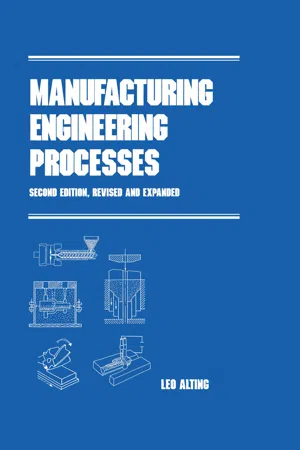Composite Material
Composite materials are engineered materials made from two or more constituent materials with significantly different physical or chemical properties. These materials are combined to produce a final product with enhanced properties such as strength, stiffness, and durability. Common examples of composite materials include fiberglass, carbon fiber, and reinforced concrete.
7 Key excerpts on "Composite Material"
- Sherif D. El Wakil(Author)
- 2019(Publication Date)
- CRC Press(Publisher)
...9 Characteristics, Fabrication, and Design of Composites 9.1 Overview A composite can be defined as a material made up of two (or more) identifiable materials (or phases), combined usually in an ordered fashion to provide specific properties different from and superior to those of the individual materials. Those two materials that constitute any composite are referred to as the matrix and the reinforcement. It is customary to classify composites based on the nature of their matrix materials. Based on that classification, there are three main groups: polymer-matrix, metal-matrix, and ceramic-matrix composites. Most naturally occurring structural materials such as timber are, in fact, composites. Moreover, the merits of crude forms of composites have been known for centuries; for instance, straw-reinforced clay was reportedly used as a building material in Egypt in 1500 BC. It is only in the past 60 years that composites—and fiber-reinforced polymers in particular—have become important engineering material. New synthetic high-strength, high-modulus fibers and new resins and matrix materials have elevated fiber-reinforced composites into the material of choice for innovative lightweight, high-strength engineered products. These developments, along with established engineering design criteria and special processing technology, have advanced fiber-reinforced composites close to the realm of a commodity material of construction. In the areas of automobile bodies, recreational boat hulls, and bathtubs and shower stalls, fiberglass-reinforced organic polymer resins have indeed become the material of choice. In more advanced applications, the first completely fiber-reinforced polymeric resin composite aircraft, the Boeing 787, came into existence in the 1980s and is now widely used by various airlines...
- Shashanka Rajendrachari, Orhan Uzun(Authors)
- 2021(Publication Date)
- Bentham Science Publishers(Publisher)
...Composites R. Shashanka, Orhan Uzun Abstract In this chapter, we have discussed the basics of Composite Materials, types, properties, and applications. Students will learn the fundamentals of Composite Materials and their importance in many engineering fields. Composite Materials can be defined as “the combination of a hard and a soft material” or “these are the materials composed of different parts with specific ratios”. This chapter comprises of the advantages and disadvantages of composites and also focuses on different fabrication methods of preparing composites. Fundamentals of nanocomposites and their recent improvements are also added in this chapter. Keywords: Ceramic matrix, Composites, Fabrication, Fibers, Fiber-reinforced plastics, Fillers, Laminates, Metal matrix, Nanocomposites, Polymer matrix, Reinforcements, Resin. 1. INTRODUCTION In recent years, Composite Materials are becoming more popular due to the possibility of fabricating high-tech materials for modern applications. Composites (see Fig. 1) are revolutionary materials that have been used in various engineering fields for more than 60 years [ 1, 2 ]. The important advantages of Composite Materials over other bulk materials are their high strength to low weight ratios, their stiffness combined with low density [ 3 ]. The reinforcing phases are always harder, stronger than the matrix constituent, and impart greater strength and stiffness to the matrix. Composite is a future technology, and therefore, more and more research work is going on all over the world to improve the microstructure, mechanical properties, electrical properties, corrosion resistance properties, and surface properties. One of the earliest man-made Composite Materials are bricks made up of straw and mud for constructing buildings during the Egyptian era, as drawn in their tomb paintings [ 1 ]...
- eBook - ePub
Composite Materials
Properties, Characterisation, and Applications
- Amit Sachdeva, Pramod Kumar Singh, Hee Woo Rhee, Amit Sachdeva, Pramod Kumar Singh, Hee Woo Rhee(Authors)
- 2021(Publication Date)
- CRC Press(Publisher)
...3 Properties of Composite Materials Arvind Kumar Chauhan, Amarjeet Singh, Deepak Kumar and Kuldeep Mishra Contents 3.1 Introduction 3.2 Properties of Polymer-Matrix Composites 3.2.1 Electrical Properties of Polymer Composites 3.2.2 Mechanical Properties of Polymer Composites 3.3 Properties of Ceramic-Matrix Composites 3.3.1 Electrical Properties of Ceramic-Matrix Composites 3.3.2 Mechanical Properties of Ceramic-Matrix Composites 3.4 Properties of Metal-Matrix Composites 3.5 Properties of Composite Materials used in Energy Storage/Conversion Devices 3.6 Conclusions References 3.1 Introduction Composite Materials have a macroscopic structure containing two or more non-soluble materials. One old and well-known example of a Composite Material is mud brick, which is prepared by fire-drying mud. It has good compressive strength but poor tensile strength. Strong fibrous straw can be a good reinforcing material to be added to mud to make excellent building blocks. The straw is used to bind clay and concrete to form an admirable building material called cob. The most appropriate properties of Composite Materials are: High stiffness and strength across a wide temperature range High Young’s modulus Highly resistive to corrosion/oxidation Low density and light weight High thermal and electrical conductivity High wear resistance. Concrete, a mixture of small stones, cement, and sand, has good compressive strength. Its tensile strength is enhanced by adding metal rods or wires, when it is called reinforced concrete or reinforced cement concrete (Figure 3.1a). One constituent in Composite Materials, the reinforcing phase in the form of fibers, particles, or flakes, is embedded in the other continuous constituent, which is called the matrix. The properties of the reinforcing and matrix phases are complementary to provide the best performance of the Composite Material for a particular application...
- eBook - ePub
Introduction to Engineering Mechanics
A Continuum Approach, Second Edition
- Jenn Stroud Rossmann, Clive L. Dym, Lori Bassman(Authors)
- 2015(Publication Date)
- CRC Press(Publisher)
...15 Case Study 7: Engineered Composite Materials In Chapter 14, we noted that some biological materials are “composites,” comprised of multiple materials with significantly different physical properties. The resulting combined materials have characteristics that are different from any of their component materials. Many engineered Composite Materials are designed with similar objectives, often yielding materials that are stronger, lighter, or less expensive than traditional materials. We characterize the components as “matrix” and “reinforcement;” Composite Materials should have at least one of each. The matrix material surrounds and supports the reinforcement materials by maintaining their relative positions. The reinforcements impart their particular mechanical and physical properties to enhance the matrix properties. Like biological materials, engineered composites are often anisotropic, due to the orientation of the reinforcements. Engineered Composite Materials include concrete (and its steel-reinforced form as well), fiber-reinforced plastic (including fiberglass), metal composites, and ceramic composites. 15.1 Concrete Concrete itself is a “composite,” in the sense that it results from the combination of several materials. It is composed of (1) coarse granular aggregate sometimes called filler, embedded in (2) a hard matrix (cement or another binder) that fills the spaces among the aggregate particles and binds them together with the aid of (3) water. The ancient Roman architect/engineer Vitruvius * first wrote down a recipe for concrete—his version included volcanic ash as the binder. The Roman Colosseum was constructed from concrete; more recently, the Hoover Dam and Panama Canal have made good use of this material. It is now the most widely used structural material worldwide. We often use steel bars (which are very strong) to reinforce concrete (which is stronger in compression than in tension)...
- eBook - ePub
- Sheraz Ahmad, Abher Rasheed, Ali Afzal, Faheem Ahmad, Sheraz Ahmad, Abher Rasheed, Ali Afzal, Faheem Ahmad(Authors)
- 2017(Publication Date)
- CRC Press(Publisher)
...Section II Testing of Technical Textiles 9 Composite Materials Testing Khubab Shaker and Yasir Nawab CONTENTS 9.1 Physical Testing 9.1.1 Surface Morphology 9.1.2 Analytical Testing 9.1.2.1 Density of Sandwich Core Materials 9.1.2.2 Constituent Content of Composite Prepreg 9.1.2.3 Content of Volatiles of Composite Material Prepreg 9.1.2.4 Ignition Loss of Cured Reinforced Resins 9.1.2.5 Void Content of Reinforced Plastics 9.1.2.6 Constituent Content of Composite Materials 9.1.3 Thermal Properties 9.1.3.1 Transition Temperatures, and Enthalpies of Crystallization and Fusion 9.1.3.2 Linear Thermal Expansion of Solid Materials 9.1.3.3 Compositional Analysis by Thermogravimetry 9.1.4 Moisture Absorption 9.2 Mechanical Characterization 9.2.1 Tensile Testing 9.2.2 Compression Testing 9.2.3 Flexural Testing 9.2.4 Impact Testing 9.2.5 Hardness Testing 9.2.6 Shear. Testing 9.2.7 Peel Testing 9.3 Non-Destructive Testing 9.3.1 Ultra-Sonication 9.3.2 Radiography 9.3.3 Shearography 9.3.4 Thermography 9.3.5 Visual Inspection References The composite may be defined as a macro-scale combined assembly of two or more components, having properties that none of the constituents possesses individually [ 1 ]. Composites are not isotropic materials, but are orthotropic, in general. They are fabricated to meet the design and functional properties of the structure. The constituent categories of Composite Material are termed the reinforcement and the matrix. Usually, the reinforcement is a collection of fibers, which are responsible for the mechanical strength of the material [ 2 ]. The fibrous reinforcements are used in a number of forms, for example, fabric, unidirectional, and chopped fibers. The orientation and composition of reinforcing fibers defines the performance properties of Composite Material. The fiber orientation is also an indicator of composite strength...
- R.A. Ilyas, S.M. Sapuan, Emin Bayraktar, R.A. Ilyas, S.M. Sapuan, Emin Bayraktar(Authors)
- 2021(Publication Date)
- CRC Press(Publisher)
...Reduced weight. Increased strength. Reduced production cost. (Arunkumar et al., 2020) Hybrid titanium composite laminates (HTCLs) Fiber-reinforced polymer composite pliesMetal alloy sheets Outstanding stiffness. Excellent yield stress. Exceptional fatigue properties. Good high-velocity impact properties. (Kazemi et al., 2020) Hybrid Aluminum metal matrix composites Silicon carbide Boron carbideFly ashTungsten Greater strength.High stiffness. Excellent thermal stability. Good wear resistance. (Dhanesh et al., 2020b) Titanium matrix composites Continuous fibersDiscontinuous particulates High specific strength. High stiffness. (Hayat et al., 2019) 1.7 Conclusions Polymers and metal waste are highly resistant to violent environmental factors and raise the risk of environmental and economic harm by their aggregation. This will further worsen the environmental and economic issues created by a higher level of polymer waste. There are many ways that have been used to overcome with this problem and one of them was recycling. Current technologies have been developing to recycle this composite. There are three methods to recycle polymers and metal composites: chemical recycling, thermal recycling and mechanical recycling. Most of the recycled polymer and metal composites show positive results: the recycled polymer has good mechanical and thermal properties, as good as virgin material. In certain cases, recycling polymers for the manufacture of new products is more costly than using virgin polymers. This is because the need for initial recycled waste preparation and treatment nearly doubles the recycled waste costs, in addition to the feedstock. Recycling processes also need to be improved to manufacture products that can compete against virgin polymers at cost. Besides that, a variation of polymer waste also needs a technologically challenging and costly disposal investment...
- Alting(Author)
- 2020(Publication Date)
- CRC Press(Publisher)
...Another example is the reinforcing of concrete with iron rods to impart the necessary tensile strength to the composite, since concrete in itself is brittle with no useful tensile strength. Today, cutting tools, electrical components, golf clubs, prosthetic devices, military helmets and bulletproof vests, sailboats, aircraft, automobiles, and so on, all utilize advanced Composite Materials. There are many types of composites and several methods of classifying them. One such method is based on the way the Composite Materials are built up: 1. Dispersion-hardening materials, consisting of a matrix filled with up to 15% particles (size <0.1 µm) of different materials. 2. Particle-reinforced materials, consisting of a matrix filled with more than 20% particles (size > 1 µm) of different materials. 3. Fiber-reinforced materials, consisting of a matrix with up to 70% fibers of different materials. 3.11.1 Dispersion-Hardened Materials Dispersion-hardened materials are normally produced by dispersing a small quantity of hard, brittle, fine particles in a softer, more ductile matrix. Pronounced strengthening and creep resistance can be induced, which decrease only gradually as temperature is increased. Examples include sintered aluminum or copper powder, consisting of an aluminum or copper matrix strengthened by particles of aluminum oxide. Applications include gas turbines and electrical components. 3.11.2 Particle-Reinforced Materials This group contains large amounts of rather coarse particles and covers the previously mentioned combination of metals including alloys and ceramics, which give reasonably good ductility, high hardness, and good strength at elevated temperatures. Particle-reinforced materials are used primarily as cutting and forming tools as described in Section 3.9.1 for carbide ceramics. The hard, stiff carbide can withstand the high temperatures of cutting, but is extremely brittle...






